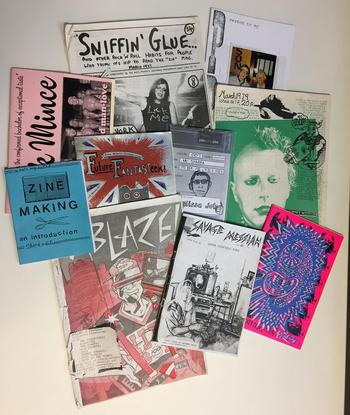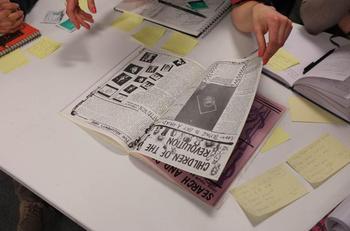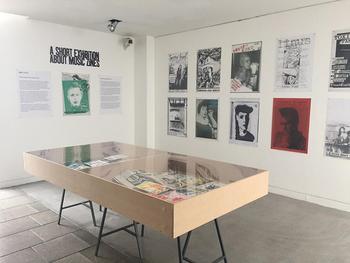Introduction
The LCC Library is located within a constituent college of the University of the Arts London (UAL) and houses a range of special collections that have been developed to support the learning and teaching of the students at LCC, and the wider UAL. As the college was formerly the London College of Printing the special collections highlight the aesthetic and technical development of printing in the West from the earliest days of the hand press to date. By 2009 LCC had changed not only its name but its emphasis from printing to design and media, but the students were still producing printed works, and the presses were still being inked. Increasingly students were being set projects to create zine-like publications, an academic turn that highlighted a new collecting route for the library, one that would support the curriculum.
Correspondingly, we had recently purchased two issues of Laura Oldfield Ford's Savage messiah Footnote 1 zine; these were important acquisitions, representing a politicised voice expressed through do-it-yourself printing. Neither artists’ books nor private press works, these publications did not entirely fulfil the existing special collections criteria, therefore these became the foundational publications of the zine collection.
Genesis of the Zine Collection
Whether zines should be collected within institutional libraries is open to debate. At LCC we felt strongly they did have a place in our library as they reflect not only a form of printing that, particularly at the time, was not often collected but they also contain histories and opinions that are marginalised from mainstream culture and representation. The act of collecting zines would preserve these alternative voices. Nonetheless, we carefully considered how we would collect, manage and promote what are essentially ephemeral and subcultural publications, created not for academic scrutiny but for circulation within small groups. Crucially, LCC Library's special collections are all accessible to the public, so the zines could be available to anybody wishing to read them. Without this guarantee it would have been harder to justify enclosing zines within an academic environment.
We created a collection statement not only to aid current purchasing but also to provide an element of sustainability. Despite the design college environment, we decided not to concentrate solely on art zines, rather we outlined the widest remit possible within the confines of space and budget: LCC Library would collect zines on any subject, from any date, and from any location, to show the history of zines and fanzines as well as contemporary manifestations, and to represent the most diverse range of voices. The Zine Librarians Code of Ethics Footnote 2 has been freely available since 2015, providing support and guidance on aspects such as acquisition, access and use. However, when the LCC Library zine collection was initiated it was one of very few zine collections in the UK, possibly the only one in an academic library, and many of the procedural and collection development decisions relating to it were therefore made in isolation, without a template.
Our response to the ethical dilemmas inherent in collecting zines was to consider them in a similar way and with the same sensitivities as we would if housing an individual's archive; despite their physical appearance, zines in many ways share more characteristics with a personal letter than they do with monographs or serials. This decision was crucial in enabling us to foster an enduring relationship with the zine community, engendered and nurtured at zine fairs and events, which remains one of the strongest influences on the development of the collection.
Collection development
The ephemeral and personal nature of zines influenced every element of collection development including acquisition and cataloguing, and in some ways challenged standard library procedures. Staff at LCC Library and UAL's Central Bibliographic Services team were unstintingly supportive and responsive as they worked with the many eccentricities of the zines. As Julie Bartel states ‘truly creative processing is…required’Footnote 3 when building library zine collections. As zines are distributed and purchased entirely outside mainstream networks, predominantly in person and with the exchange of small sums of cash, the library finance team agreed to support the use of an in-house receipt for the reclamation of librarian expenses and later, as the collection grew in size and popularity, larger sums were released in advance of zine fairs to enable a more sustainable approach to purchasing.
Clear statements of bibliographic data such as author, place of publication, and date are often elusive or absent in zines. Whilst this negation of formal publishing is part of the charm of zines for the creator and reader it can be time-consuming for library cataloguers as it is often essential to skim read the entire zine to garner information. Pseudonyms are common in zine culture and anonymity, particularly to protect the expression of personal or radical narratives, is important. To support this essential concealment, we decided at LCC not to add any see-references, even when these were known.
In addition to this active collecting, the LCC collection has benefitted from numerous generous donations, both small and large, which have significantly bolstered the Riot Grrrl, perzine, comix zine and music fanzine sections. These donations are gratefully received as many of these older zines rarely, if ever, become available so long after creation. Donations also prompted us to consider how to inform zine creators whose works were added to the library, unbeknownst to them, via a third party. We elected to contact the creators of every zine in the collection, ostensibly asking if we could use images of their publications on the OPAC and in other forms of collection promotion, but this method had the triple value of transparency, copyright management, and direct communication with zine makers.
Diverse voices
It is important that librarians work to diversify and ensure that collection development within libraries is as inclusive as possible. This can be challenging when representation of certain voices is accorded higher exposure in published academic works. Anne Goulding applies Bourdieu's ideas about cultural capitalFootnote 4 to the academic library, with inequality coming from differences in access to and possession of cultural capital, and librarians acting as ‘cultural intermediaries’Footnote 5 who play a crucial role in providing access to knowledge and cultural artefacts, the ‘objectified cultural capital’.Footnote 6 The inclusion of alternative or underground publications ensures voices outside or against the mainstream are represented, allowing LCC's special collections to evolve to incorporate inclusivity and diversity. The zine collection contains zines that are varied in topic: class, sexual identity, gender and body politics, race, ethnicity and faith, mental health, and personal interest. Crucially, these alternative perspectives mean that students see their own voices represented in the collection, through examples of student work or through identification with zine creators with similar backgrounds or experiences. This is fundamental for widening participation, breaking down barriers and encouraging students to see the library as an inclusive and welcoming space.
Teaching, learning and visual literacy
Since the beginnings of the zine collection there has been an increase in interest in its use in teaching and learning. Librarians have delivered sessions and workshops for FE, undergraduate, and postgraduate students across UAL, as well as to visiting students from UK and international institutions. A number of courses set projects around zines, that the library supports through sessions, providing a brief history of zines and allowing students to see examples for inspiration. These can be tailored to specific course needs, to focus on photography, radical networks or collaborative zines, for example. Zine reading groups, so far focusing on LGBTQ+ and women's voices, offer the opportunity for students to hear readings and participate in discussions around emerging themes.
The visual language of zines means they are of interest to courses with a design focus across the university, not least because the ‘graphic language of resistance’Footnote 7 used in the early punk fanzines has been influential in design and absorbed into design history.Footnote 8 But zines are cultural rather than design objects. As Stephen Duncombe suggests, their DIY aesthetic comes out of necessity, as a quick and inexpensive means of transmitting ideas, or in opposition to the mainstream, with design rules disregarded intentionally, creating an ‘anti-style’.Footnote 9 Punk fanzines, for example, point to a specific period of socio-economic, cultural and political change, the ‘product of agency, a means of participation and a platform for creative and political expression’Footnote 10 so it is important for students to read zines within these contexts. LCC librarians have expanded information literacy teaching through zine visual literacy workshops, using ARCL's 2011 Visual Literacy Competency Standards for Higher Education as a framework.Footnote 11 These sessions include activities that introduce students to ways of reading zines, examining both the descriptive elements (design, text, image, material, typography, appropriation and alteration) whilst also encouraging students to interrogate zines as documents which reveal the personal, political, and socio-cultural contexts in which they were created.
Learning using zines offers new ways of teaching information skills to students. In recent years, librarians at LCC have also used ACRL's 2016 Framework for Information Literacy for Higher Education as a lens through which to view and re-examine information literacy teaching.Footnote 12 The standards identify information literacy ‘threshold concepts’,Footnote 13 including the ability to see ‘authority as constructed’ and ‘scholarship as conversation’.Footnote 14 Zines expose students to alternative authorities and show the potential of DIY self-publishing as a space for freedom of expression. Zine-making workshops themed around poetry, creative writing, or sketchbook research, run in collaboration with course tutors and academic support colleagues, have encouraged students to question authoritative texts and see that knowledge is not just something that other people make. They empower students to express their ideas, develop their own voices and construct their own narratives.
Supporting research
The zine collection is increasingly attracting widespread recognition as a nationally significant collection, with visits from researchers within UAL and other UK and international universities. This is as a result of personal networking and outreach by the collection librarians, word of mouth within the zine and academic communities and a greater social media presence through the LCC zine collection Facebook page.Footnote 15 The growing popularity of the collection means that although we have not previously recorded research impact in a consistent way, we are now retrospectively contacting researchers and recording all new research so as to measure and reflect the impact library collections have on research outputs. Researcher Laura Cofield used the collection to research chapters in Ripped, torn and cut: pop, politics and punk fanzines from 1976, to be published by Manchester University Press in 2018.Footnote 16 LCC academics Frania Hall and Anne Coddington are currently conducting content analysis of the collection to explore socio-cultural context for and changes in zine cultures. They held an open seminar related to their research in July 2017.Footnote 17

Fig. 1. Zines from the LCC Library zine collection (image © LCC Library)
Displays and Exhibitions
Displays and exhibitions are an important way to promote the zine collection and collaborate with wider communities. Items from the collection are displayed during monthly special collections displays in the library, and more recently in larger exhibitions, both within the university and externally. In 2017 we co-curated an exhibition of LGBTQ+ zines in the library with UAL academics EJ Scott, the creator and curator of the Museum of Transology Footnote 18 and Sina Shamsavari, creator of the queer comic zine Art fag. Footnote 19 The curators selected zines and contributed texts for a mini-zine to accompany the exhibition. We ran supporting events for UAL's Research Fortnight, including an LGBTQ+ zine session and reading group. Hosting circulating exhibitions, such as the Future fantasteek! UK and USA Tour in 2011Footnote 20, have allowed us to create links with other institutions and the zine community itself.
A Short Exhibition About Music Zines, co-curated with Jen Kavanagh, was an opportunity for us to take collections out of the library into college gallery space and promote the collection across UAL and externally.Footnote 21 The exhibition provided a brief history and overview of music zines in the UK, alongside a case study through Nick Mann's influential punk, metal and hardcore music zine, A short fanzine about rocking (ASFAR).Footnote 22 The exhibition generated a great deal of interest in the collection, new connections with students, academic staff and the zine community, and additional donations. We also lend zines to external exhibitions, allowing us to promote the collection to an even wider audience. Some 200 zines from the collection were displayed as part of Fanzines: A Cut-and-Paste Revolution at the Barbican Music Library in 2016.Footnote 23 The collection has also featured on mainstream television. In a 2016 Artsnight special on the legacy of British punkFootnote 24, Sonic Youth's Thurston Moore visited LCC to see a selection of punk fanzines and talk to Tony Drayton about how Mark Perry's Sniffin’ glue Footnote 25 and a gig by The Damned provided the inspiration and impetus to set up his own zine, Ripped and torn in 1976.Footnote 26

Fig. 2. Student activity in a zines session (image © UAL Academic Support)
Future of the collection
As the collection has grown, one of the challenges to a small team is the processing and cataloguing of a backlog of items. We have recently created a searchable list of uncatalogued zines so we can easily identify, use and prioritise zines for cataloguing. When purchasing online or from zine fairs the emphasis is now upon continuing the work of diversifying the collection, identifying groups or identities which may not yet be represented. UAL has many international students, for example, so we are increasing the diversity of nationalities and languages represented.

Fig. 3. A Short Exhibition About Music Zines in the LCC Lower Gallery (image © LCC Library)
In developing the collection the focus is always upon exploring ways in which zines can be used in teaching and learning. We recently purchased two 1940s US science fiction fanzines that will allow us to show examples of where the zine self-publishing movement began. We continue to receive requests for zine sessions from courses within UAL and beyond, each year developing new content to meet changing course and curriculum needs. Two librarians work within the special collections team delivering zine sessions; increasing demand for these sessions, along with the need to balance zine-work with other aspects of our roles, means we are also considering developing a ‘zines teaching resource’ which academic staff can borrow to use in the classroom.
Conclusion
In the 8 years since its inception, the LCC Library zine collection has provided us with new ways of connecting with students and other communities and we have seen how these ephemeral publications tangibly inspire those who engage with them. The immediacy and accessibility of zines means they also offer an opportunity for greater community engagement. We are exploring ways in which we can engage with the local and wider community, through widening participation work such as sessions for secondary and further education students and community workshops and exhibitions.
Eight years ago, we did not predict that the LCC Library zine collection would so rapidly develop from those two issues of Savage messiah to 4,000 widely varied and heavily used zines. Whilst the organisation of the zine collection has in ways been challenging and required library staff working with it to adopt creative approaches to collection development, it has also offered the library many new opportunities for supporting research, information literacy and outreach. We look forward to what the next eight years might bring.





